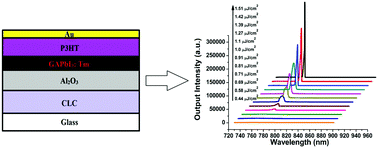Low threshold lasing from novel thulium-incorporated C(NH2)3PbI3 perovskite thin films in Fabry–Pérot resonator†
Abstract
Organic–inorganic hybrid halide perovskites are desirable candidates for application in photovoltaics and lasing. However, enhancing the lasing performances of these perovskites with a lower threshold and higher quality factor is still a challenging issue. Thus, herein, we fabricated a Fabry–Pérot resonator using an active layer of novel C(NH2)3PbI3:Tm thin films with a reflecting layer of cholesteric liquid crystal (CLC), spacer layers of Al2O3 and poly(3-hexylthiophene) (P3HT) and back reflecting layer of Au to improve the lasing performances of hybrid halide perovskites. The incorporation of thulium further improved the optical properties of the C(NH2)3PbI3 perovskite thin films by enhancing the insertion of organic and inorganic molecules. Furthermore, the introduction of a cholesteric liquid crystal layer greatly enhanced the single-mode lasing performances of GAPbI3:Tm with a low threshold of 0.70 μJ cm−2. Interestingly, the Fabry–Pérot resonator of CLC/Al2O3/C(NH2)3PbI3:Tm/P3HT/Au achieved a high quality factor of 2500. This work proves the potential of C(NH2)3PbI3:Tm perovskites in lasing. Therefore, rare earth element-incorporated guanidinium lead iodide can result in a dramatic change in future lasing applications owing to its desirable optical properties.



 Please wait while we load your content...
Please wait while we load your content...